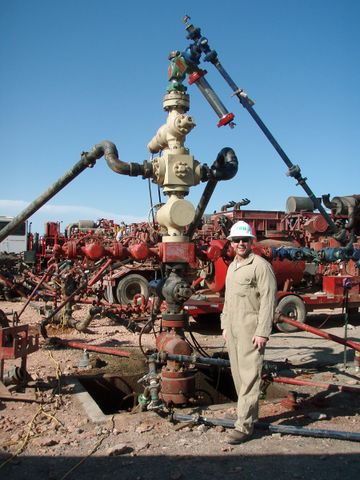Fracturing fluid

Fracturing fluid is a general term for the liquid that is pumped underground during hydraulic fracturing processes. Hydraulic fracturing creates small fissures in sub-surface rock formations to increase flow of fluids. In these fracturing processes, large amounts of these water-based fluids containing a variety of chemicals are pumped into the target formation.[2]
The potential harm to human health and the environment as a result of the use of these fracturing fluids is a topic that is widely discussed. Despite the potential associated health and environmental concerns, fracturing fluids are used to obtain oil and natural gas from formations that otherwise would not produce these fossil fuels.
Composition
The chemical composition of hydraulic fracturing fluid varies greatly, as some companies have developed their own specialized formulas. However, there are generally the same types of additives included in the water-based liquid. Fracturing fluids are primarily water but contain between 3 and 12 additive chemicals that each serve a specific purpose.[2]
One major type of additive used are friction-reducing additives known collectively as slickwater. The addition of these friction reducing fluids allows the fracturing fluid to be pumped into the formation more quickly and at a lower pressure than if water alone were used.[2] Other additives that can be included are biocides which prevent microorganism growth in the fractures, additives that prevent the corrosion of the metal pipes, and acids. In addition to these fluid additives, a propping agent known as a proppant is added. These proppants are generally silica or sintered bauxite in granular form and are injected into the newly created fractures to keep them open.[2]
Overall, the concentration of additives in slickwater fracturing fluids is around 0.5%-2%.[2]
Environmental Concerns
There are some environmental concerns associated with the use of fracturing fluid. Since hydraulic fracturing fluid is mostly water, the water use associated with it is a concern if it is not recycled and disposed of properly. Another concern associated with fracturing fluid are the chemicals within it, and their potential release into the environment with any operational leaking that may occur.[3] These chemicals can include radium (which is used to trace the flow of fracturing fluid), lead, uranium, and mercury, among others.[4] One concern is that the fluids from fracturing operations could leak out of wells and percolate into groundwater, contaminating potential drinking water supplies. The chemicals in the fracturing fluid could be harmful to humans if ingested. Overall, the use of a proper well casing reduces the chance of water becoming contaminated from fracking fluid chemicals. However, chemicals can leach into groundwater from wastewater holding ponds that contain used fracturing fluid.
Many major fracturing companies do not reveal the exact mixtures of chemicals they use. Those opposed to fracturing say that this is motivated by the hazardous nature of the chemicals. The industry has regularly stated that the formulas are industry secrets kept to allow companies to maintain a competitive advantage.[5]
For Further Reading
- Hydraulic fracturing
- Fluid
- Water
- Pressure
- Groundwater
- Or explore a random page
References
- ↑ Wikimedia Commons. (September 20, 2015). Well Head [Online]. Available: https://upload.wikimedia.org/wikipedia/commons/d/db/Well_Head_where_fluids_are_injected_into_the_ground.JPG
- ↑ 2.0 2.1 2.2 2.3 2.4 Geology.com. (September 17, 2015). Hydraulic Fracturing Fluids [Online]. Available: http://geology.com/energy/hydraulic-fracturing-fluids/
- ↑ Geological Society of America. (September 20, 2015). Water Use: Hydraulic Fracturing [Online]. Available: http://www.geosociety.org/criticalissues/hydraulicFracturing/waterQuality.asp
- ↑ Earth Works. (September 20, 2015). Hydraulic Fracturing [Online]. Available: http://www.earthworksaction.org/issues/detail/hydraulic_fracturing_101#.VZLZiflViko
- ↑ FracFocus. (September 20, 2015). Chemical Use in Hydraulic Fracturing [Online]. Available: https://fracfocus.org/water-protection/drilling-usage

